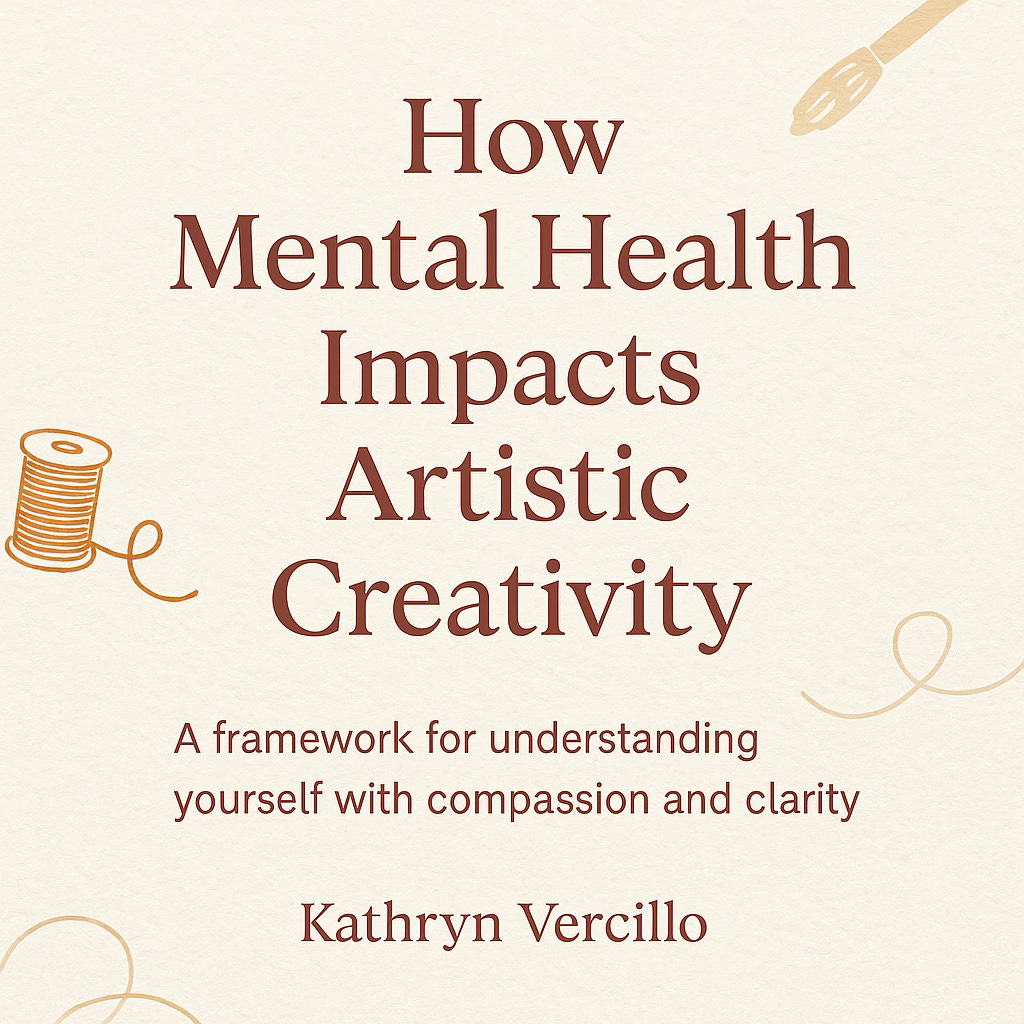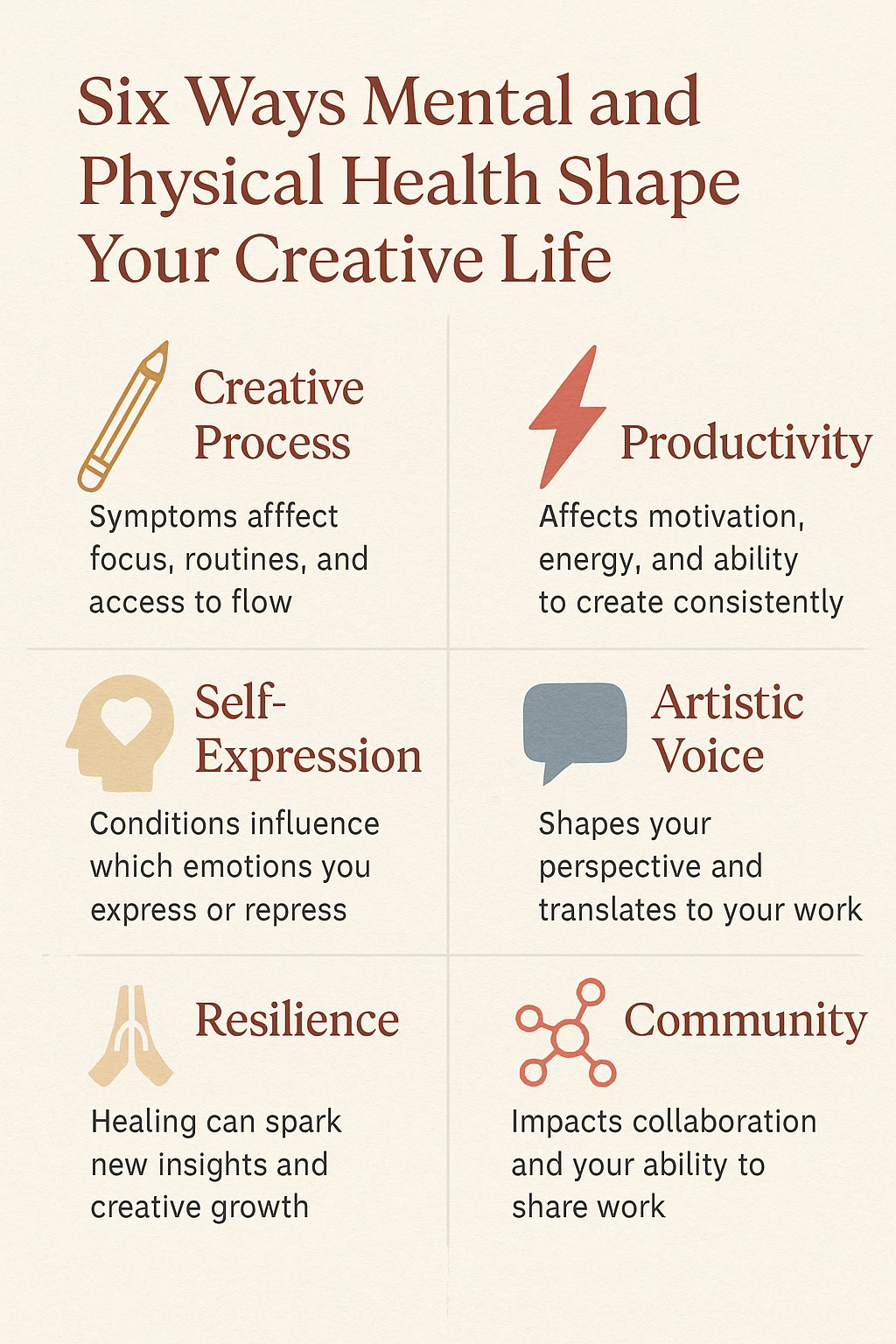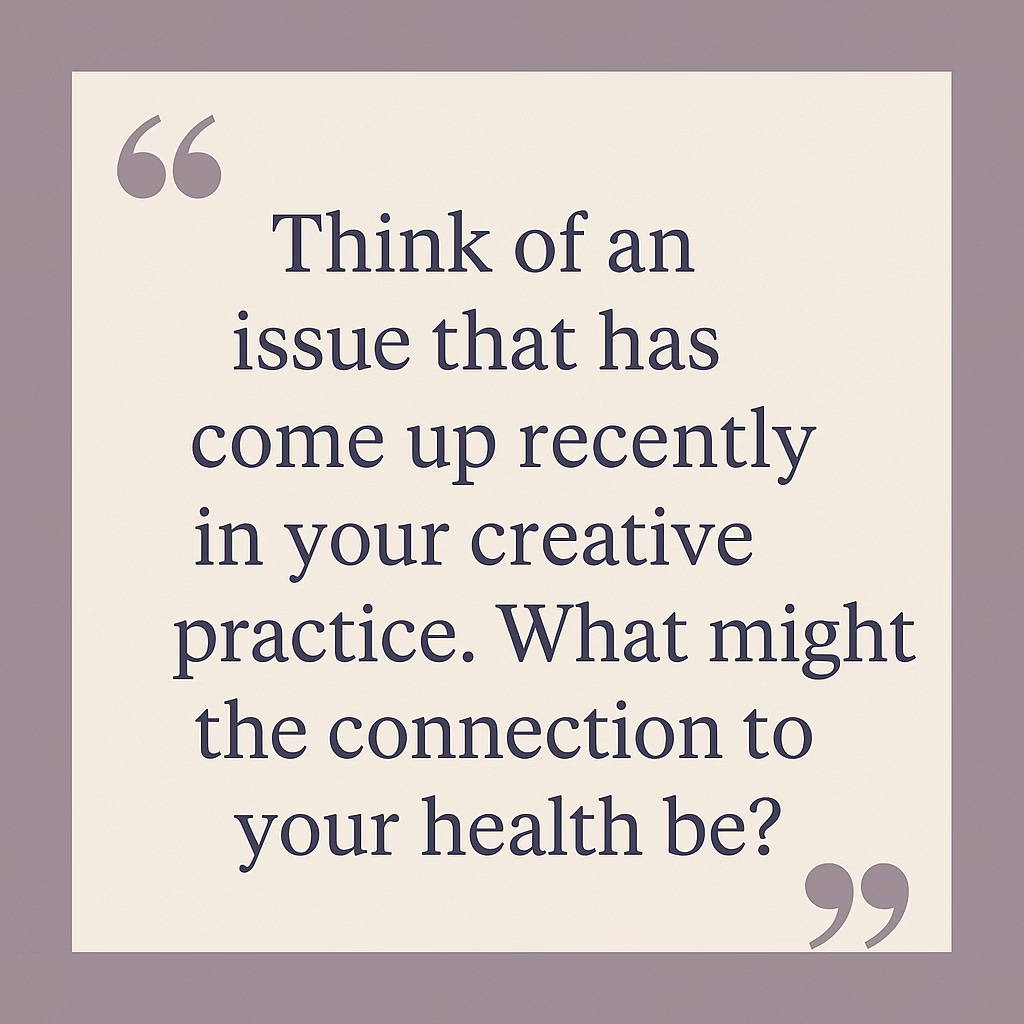How Mental Health Impacts Artistic Creativity: A Framework for Self-Awareness
Understand how emotional, cognitive, and physical health symptoms shape your creative process and how to work with yourself instead of against yourself.
There’s a very specific kind of pain that comes when you feel disconnected from your creativity. If making things has always been central to who you are, it can be disorienting and disheartening when that part of you goes quiet. You might be experiencing creative blocks, avoidance, exhaustion, or bursts of activity followed by collapse. And you might be blaming yourself for it.
In reality, many of us are creating within bodies and minds that are carrying a lot. Mental and physical health symptoms (diagnosed or not, chronic or cyclical) shape how we show up in our creative lives. That shaping isn’t inherently bad. But when we don’t acknowledge it, when we try to override it, we often end up feeling broken.
This is something I know firsthand. I have been a working writer-artist in San Francisco since 2006 while living with a recurring and sometimes debilitating mental health condition. There have been stretches of time when writing a paragraph felt like a climb up a mountain made of fog. There have also been moments when I rediscovered joy through crochet or fiber art, moments that didn’t just reignite my creativity but truly brought me back into my body.
Alongside lived experience, I also have a Master’s degree in Psychology and years of research and writing at the intersection of art, health, and healing. I have developed a framework I now use to help other creatives better understand their own intersections of health and creativity. This framework is not a diagnostic tool. It is a map for reflection, one that can help you move from self-judgment to self-awareness, and from stuckness to clarity.
This post walks through that framework in depth. I hope it helps you see yourself a little more clearly. And if you’d like help applying it to your life, I’d love to support you in a one-on-one session.
Your Health Is Already Shaping Your Art, Whether You Notice It or Not
Mental and physical health are not separate from your creative practice. They influence everything from how you sit at your desk to how you finish a painting to how you talk about yourself as an artist. Sometimes they do so in obvious ways, like fatigue that makes it hard to finish a project. Sometimes it’s more subtle, like anxiety that keeps you from sharing your work or burnout that makes every idea feel hollow.
In one of my earlier Substack pieces, I wrote about trying to get my voice back after years of writing on autopilot. I had written so much content that I could no longer hear my own rhythm. I felt like I had been shaped more by SEO checklists and deadlines than by my creative instincts. What I realized is that when we are disconnected from ourselves (because of symptoms, pressure, illness, or overwork) our art becomes disconnected too.
Instead of forcing yourself to push through, you can begin to notice. You can learn to name what’s happening and adjust how you relate to your art. You can work with what you’re carrying instead of constantly fighting it. That starts with understanding where and how health shows up in your creative process.
The Six Core Areas Where Health Impacts Creativity
This is the framework I use in my own practice and with the clients I support in one-on-one creativity sessions. Each area is a lens. When explored together, they offer a whole-person view of how your health might be influencing your creative life.
Creative Process
Your creative process is more than just how you work. It includes your rituals, your rhythms, your emotional states, your relationship to time and energy, and your ability to enter flow. Symptoms like anxiety, depression, ADHD, or chronic pain can interrupt your ability to start, sustain, or finish projects. They can change the pace of your process or the way you relate to it.
There have been times when I couldn’t hold focus long enough to complete a page of writing. I shifted to working in five-minute increments with yarn instead. That small change helped me stay connected to creative motion without demanding energy I didn’t have. It didn’t “fix” the symptoms, but it met them where they were.
What to reflect on:
Has your creative rhythm changed over time?
Do you feel resistance or dread when approaching your work?
What supports your process when symptoms arise?
Consider your instinctual reactions to the following phrases:
creative flow and anxiety
creative routines for neurodivergent artists
creativity and mental health
Creative Productivity
Productivity is a loaded word in the creative world. Many of us tie our worth to our output, even though mental and physical health can make consistent productivity impossible. Depression, chronic illness, and trauma often show up as fatigue, disorganization, or procrastination. But these aren’t failures. They are signals.
In my own life, I’ve had to redefine what “enough” looks like over and over. Sometimes that means giving myself credit for simply thinking about a project. Other times it means setting kinder goals. I’ve learned that slow work is still real work.
What to reflect on:
Are you judging yourself for how much you’re producing?
Do you notice patterns of overworking followed by burnout?
How do you measure progress when you’re not creating at full capacity?
Consider your instinctual reactions to the following phrases:
creative burnout recovery
low energy productivity
how to create during depression
Choice of Medium and Materials
Health affects the medium we choose, or the one we can continue using. When I was overwhelmed by language, I picked up yarn. Crochet helped me regulate through repetition, texture, and breath. That shift didn’t mean I stopped being a writer. It meant I was listening to what my nervous system needed in that season.
Sometimes people resist changing mediums because it feels like failure or identity loss. But creative adaptability is a strength. Switching to drawing, collage, sewing, voice memos, or found poetry can be an opening, not a detour.
What to reflect on:
Does your current medium feel accessible to your body and brain?
Are you clinging to a form of art that no longer fits your capacity?
What would happen if you followed your comfort instead of your habits?
Consider your instinctual reactions to the following phrases:
accessible art practices
craft and mental wellness
sensory-friendly creativity
Creative Content
Our inner worlds shape what we make. Mental health experiences influence the stories we tell, the colors we choose, the metaphors we lean into. Sometimes we explore trauma, grief, or resilience in our work. Other times we avoid certain themes because they feel too vulnerable.
In Hook to Heal, I wrote that creating can be a way of processing emotion. But not every emotion is ready to be processed on the page or canvas. It’s okay to step back. It’s also okay to step in and tell the truth with all its edges showing.
What to reflect on:
Are you avoiding certain topics in your work out of fear or overwhelm?
Do you feel pressure to package your pain into something palatable?
Are you craving depth but unsure how to approach it safely?
Consider your instinctual reactions to the following phrases:
trauma-informed creative process
mental health in artistic themes
vulnerable art making
Self-Perception and Identity
When your creative output changes, your self-perception often shifts too. I have worked with so many clients who say, “I don’t know if I’m an artist anymore.” I’ve said it myself during long stretches of silence. But art is not only in the finished product. It’s in the questions you keep asking. It’s in the materials you keep reaching for, even when the results don’t look how you imagined.
One tool I use is a “brag book”—a collection of work, kind words, memories, and milestones that remind me of who I am when I forget. It’s not about ego. It’s about anchoring your identity in something real when your symptoms try to erase it.
What to reflect on:
Do you feel like you have to earn the title of artist again and again?
What stories are you telling yourself about your value?
What would it mean to claim your creativity as it exists right now?
Consider your instinctual reactions to the following phrases:
creative identity and mental health
imposter syndrome for artists
artist self-esteem
Creative Business and Sustainability
If you earn income from your art, health impacts your ability to show up consistently, meet deadlines, engage with clients, and promote your work. The business side of creativity can be deeply dysregulating for people with chronic conditions. But you don’t have to hustle through it. You can build systems and boundaries that honor your limits.
Some of my clients move to asynchronous models, batch their energy, or add more structure to their intake processes. Others rework pricing or communication strategies to make space for slowness. There is no one right way to do it. There is only the right way for you.
What to reflect on:
Is your business model aligned with your actual capacity?
Are you burning out trying to meet external expectations?
Where can you create more ease or honesty in your workflow?
Consider your instinctual reactions to the following phrases:
sustainable art practice
slow creative business
artist mental health support
You Don’t Have to Untangle This Alone
If this framework feels like a mirror, that’s probably because you are already living inside it. Maybe you have been carrying creative shame for years. Maybe you are coming back to art after illness or trauma. Maybe you are simply trying to make space for your work in a body that feels unpredictable.
These are the conversations I hold with people every day in my 1:1 Creativity and Wellness Sessions. Each session is personalized, compassionate, and grounded in both lived experience and training. I bring together elements of narrative therapy, expressive arts, somatic awareness, and integral psychology to support you in reconnecting with your creativity in a way that feels honest, accessible, and nourishing.
This is not therapy. But it is therapeutic. And you don’t have to be in crisis to benefit. You just have to be curious about what’s possible when you stop blaming yourself and start listening more closely.
Book Your Session
Sessions are held over Zoom, with alternative formats available (email/text-based coaching for those who prefer it).
Don’t see a time that works for you? Send me an email and we’ll work something out.
ZOOM ALTERNATIVES NOTE: these are designed as hour-long Zoom sessions. However, everyone’s needs and communication preferences are different, and I am happy to work with you in alternative ways including via an exchange of emails or text messages. Email me to figure out what works best.
A Prompt to Help You Begin
What is one way your mental or physical health has shaped your creativity in the past month?
Let that question sit with you. No need to fix it. Just begin to notice. That noticing is a creative act in itself. And it might be the beginning of something new.






